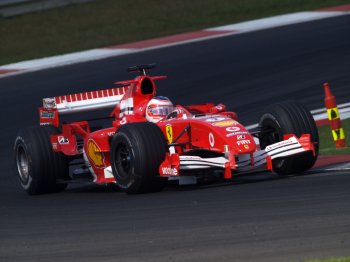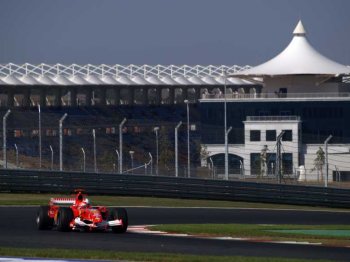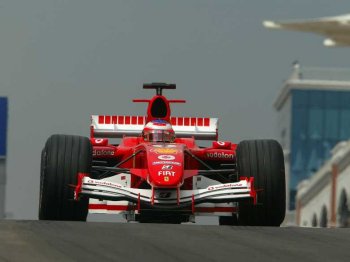|
After the race
in Budapest, Formula 1 seemed to be entering a period of
time reminiscent of an era when life was lived at a more
relaxed pace. To start with, there would be three weeks
before the next grand prix and secondly, the race cars and
equipment would travel there and back from Trieste, Italy by
ship.
Last year, Turkey became the first ever race described by
the teams' logisitics people, as a "float-away" as opposed
to "flyaway," which describes the races outside Europe,
where teams have to get organised without their trucks or
motorhomes. Turkey falls between the two in that the trucks
and motorhomes in the paddock mean the event has an
identical feel to the European races, but the vehicles do
most of the journey by sea, rather than by road.
In charge of Scuderia Ferrari Marlboro's logisitics
operations is Miodrag Kotur, whose career in racing is
closely linked to that of Ferrari Managing Director Jean
Todt, "I started working in motor sport in 1988 at Peugeot
Talbot Sport, which is where I got to know Jean Todt and
worked on Rallye Raid events such as the Paris-Dakar and
other African races," says Kotur. "It was a stroke of luck
that I got the job and I guess you could say I came in
through the back door! After Rallye Raid events, Peugeot
switched to sports car racing with the famous 905 and it was
at this point that I got more involved with the logistics
side of the operation.
"After a one-two-three finish in the Le Mans 24 Hours, Mr
Todt signed a contract with Ferrari and he asked if I wanted
to come with him. It was not an offer I could refuse, going
to work for Ferrari! I was young and unmarried and I didn't
speak Italian." At first, Kotur's main role was to oversee
Todt's move from France to Italy and everything that
entailed, before working full-time for the Scuderia's
logistics operation from 1994.
Despite over a decade in the role, Kotur still has plenty of
enthusiasm for his work. "It's a job I like where we can
always improve with different and unexpected things to do,"
he maintains. "You have to try and anticipate what might
happen and it is interesting because logistics here at
Ferrari, involves a wide range of responsibilities, such as
transport, hotels, team kit and catering. It's such a big
job there is no time to get bored."
Last year's inaugural Turkish Grand Prix was a good example
of the way Kotur's job can throw up the unknown as it was
the first time F1 cars went to a race by boat. "It all went
well," recalls Kotur. "We hesitated between going by boat or
sending the cars by road from Hungary. But given that there
might have been complex problems with getting through
customs in countries like Serbia and Bulgaria that are not
in the EU, we opted for the boat from Trieste to Istanbul.
It is a 56 hour sailing. It was really well organised by a
company that specialises in international truck
transportation. They reserved ships just for F1 without
allowing normal trucks on board. It was especially important
for the return trip to Trieste to run on time as we had the
Italian Grand Prix at Monza just a fortnight later.
|

 |
|
Last year, Turkey became the first ever race
described by the teams' logisitics people, as a
"float-away" as opposed to "flyaway," which
describes the races outside Europe, where teams have
to get organised without their trucks or motorhomes.
Above:
Ferrari at the 2005 Turkish Grand Prix. |
|
|

 |
|
After the race in Budapest, Formula 1 seemed to be
entering a period of time reminiscent of an era when
life was lived at a more relaxed pace. To start
with, there would be three weeks before the next
grand prix and secondly, the race cars and equipment
would travel there and back from Trieste, Italy by
ship. Above: Ferrari at the 2005 Turkish Grand Prix. |
|
|
"With a 56 hour crossing there was no question of missing
the boat. This year, our trucks will leave Trieste on Friday
18 August and we arrive on the Monday morning for the short
drive to the circuit outside Istanbul. Once we are there it
is just like any other European race, except that it takes
place in Asia. The infrastructure is all new with plenty of
room as the circuit has been designed to have a long life
while meeting the most up to date requirements of the teams.
The Turkish customs cooperate and facilitate all our
administrative needs. Everything is done really quickly and
we certainly had no problems last year."
While getting into Turkey went smoothly, one lesson learnt
from the 2005 race is that traffic on the roads from
Istanbul to the circuit is very heavy and so contingency
plans are being put in place for this year. "Getting to the
track in the morning is the biggest problem and we hear the
traffic could be even worse this year," warns Kotur.
"Crossing the main bridge over the river Bosphorus is the
biggest hold-up. Some of our cars did not have the telepass
and it could take half an hour to cross the bridge. So, this
year, we will have chauffeurs as they are local and know the
short cuts and they also understand the unusual driving
style of the local people there!."
Istanbul was a new experience in 2005 and now it seems that
for 2007, teams will face another new challenge, when
Formula 1 is due to visit the Japanese Mount Fuji circuit
for the first time since 1977. "I went there after Australia
this year, travelling from Melbourne to Tokyo to visit the
circuit and the surrounding areas to look at the hotels,"
says Kotur. "The circuit itself is not bad, although it
currently lacks the team offices and kitchens. They are
planning that now. What worries me is that in terms of
hotels and access to the circuit there could be some
difficulties. There are not many hotels and they are far
away. Getting to the track will be very difficult. From the
centre of Tokyo it takes an hour but when a race is on it
can take four to five hours. Access is by small country
lanes and everyone wants to go by car. There is not much
parking, so they will stop all traffic in a 20 kilometre
radius and only let pass holders through. I used to think
Suzuka Circuit was difficult logistically, but Mount Fuji
seems to be a much more complicated scenario."
No matter how complicated it is the job of Kotur and his
staff to ensure that everything runs smoothly once the race
team arrive at a new venue. For the drivers, engineers and
mechanics, the actual location of a circuit should have
absolutely no effect on the way they carry out their job of
running the cars on the track and the Scuderia's logistics
department will be doing their utmost to ensure that is the
case.
|
|
|
|
![]()
![]()